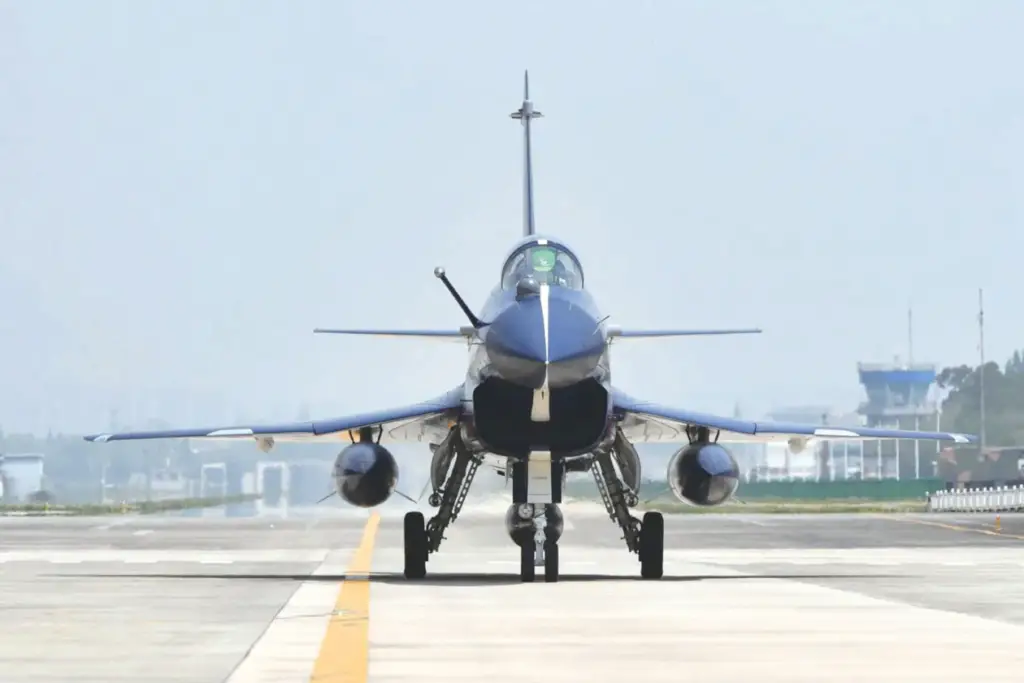On the 16th, Colonel Xie Peng, a spokesman for the Chinese Air Force, said that the J-10C fighter jets would be issued to the Chinese Air Force’s August 1st Air Demonstration Team as part of the Air Force’s development strategy for equipment development. Since its inception, the demonstration team has changed their equipment seven times.
From May 23 through the 27th, the August 1st Air Demonstration Team will be at the 16th annual Langkawi International Maritime and Aerospace Exhibition. This will be their first time performing internationally with the new plane. According to experts cited by the Global Times, China’s rapid pace of modernisation of Air Force equipment is on display with the inclusion of the J-10C in the August 1st Air Demonstration Team. The August 1st Air Demonstration Team is like the People’s Air Force’s flying business card; it spreads a message of peace and open dialogue and demonstrates the force’s softer side.
The August 1st Air Demonstration Team’s decision to replace the J-10C has garnered much attention. This Chinese-made fighter plane is a third-generation, supersonic, multi-role fighter. According to military expert Zhang Xuefeng, who spoke with reporters from the Global Times, the J-10C improves upon previous versions of the J-10 by adopting a clamshell-type air intake and reshaping the nose to maximise its aerodynamic arrangement. The clamshell air intake offers a high total pressure recovery, low weight, excellent stealth performance, and a simple design. The J-10C has vastly improved over the J-10A in terms of combat performance because of the addition of an infrared tracking and targeting system (IRST) and enhanced avionics systems such as onboard radar. One could say it’s advanced by half a generation.
On April 16, 2018, the J-10C entered active combat service, bolstering the Air Force’s offensive and defensive combat capabilities and improving its capacity to accomplish mission objectives. Only five years and one month passed between April 16, 2018, and May 16, 2023, when it was announced that the August 1st Air Demonstration Team would receive the J-10C. While the Chinese Air Force has been modernising its equipment rapidly, the August 1st Air Demonstration Team has only been using the J-10A for performances since 2009.
According to Zhang Xuefeng, the August 1st Air Demonstration Team is one of just a handful of teams worldwide to employ a third-generation fighter jet as its demonstration aircraft. China has joined Russia and the United States in using a third-and-a-half generation fighter jet (fourth-and-a-half generation by international criteria) as a demonstration aircraft with the addition of the J-10C to the team. The rapid development of Air Force hardware is reflected in this as well. When China first started outfitting third-generation jets, elite troops were the only ones with access to the most cutting-edge fighters. There has been considerable development in the equipment of the People’s Air Force, as seen by the widespread deployment of the J-20 across China and the proliferation of aircraft of the three-and-a-half generation.

J-10C: Multiple Highlights
The August 1 Air Demonstration Team’s J-10C aircraft continue to sport the same overall livery as the previous design, with sapphire blue as the primary colour and white, grey, and red patterns providing contrast. This design was inspired by the “Sword of Victory” spirit of the Chinese Air Force, which seeks to dominate the skies and protect national interests.
Visual distinctions exist between the J-10Cs flown by the August 1st Air Demonstration Team and those flown by regular military troops. The larger dorsal fin is one of the most noticeable changes. According to Zhang Xuefeng, the enlarged dorsal fin might store additional fuel or smoke agents, improving the aircraft’s directional stability. These changes have greatly boosted the J-10C’s performance.
Chinese Air Force analyst Fu Qianchao told the Global Times that the J-10C outperforms its predecessors regarding flight performance, citing the aircraft’s superior flight control and manoeuvrability. He thinks the greater precision control of the J-10C fighter jet’s acceleration and deceleration makes it a great tool for formation flying. The performance of the engine is being put to the test by the choice of a demonstration aircraft. A plane that accelerates swiftly in response to the pilot’s throttle input is more likely to maintain formation with other planes but also looks better.
In addition, the J-10C’s improved information and robust system-level joint combat capabilities can improve coordination between members of the flight formation. As a result of improvements to its combat radius, range, and aerial refuelling capabilities, the August 1st Air Demonstration Team can now fly even further. According to Fu Qianchao, these advancements mean that the August 1st Air Demonstration Team may one day be able to perform overseas without stopping at airports for refuelling in the middle of long-distance flights.
The equipment switch reportedly took the August 1st Air Demonstration Team members just over a month to complete. While the control systems of the J-10A and J-10C are quite similar, the J-10C is slightly larger; thus, the crew must continually test and master the aircraft’s optimum performance throughout a wide range of speeds and altitudes.
